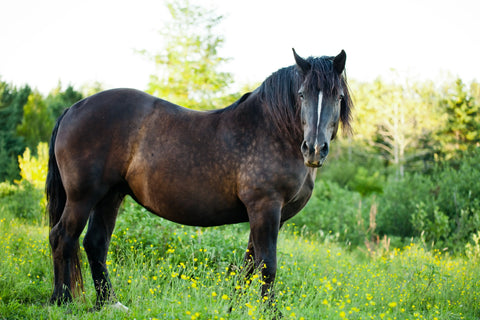
How Does Horse Reproduction Work?
of reading - words
The horse reproduction is a unique moment in the life of a horse owner. In this article we present to you its progress from the mating of the horses to the birth and care of the foal.
Horses mating
Mares reach puberty around 18 months of age and undergo an estrous cycle, or heat cycle. Mares go into heat several times during the breeding season starting in spring, which typically continues through long days and ends as winter approaches.
Exposing mares to extended periods of artificial light can allow the horse's breeding season to begin earlier. During this breeding season, mares ovulate regularly every 3 weeks, but they are only in heat and receptive to a stallion for 2 to 8 days. The heat is generally longer at the beginning of the season (spring) and only 2 to 3 days at the end of June.

The birth of the horse
The mother, or mare, carries her foal for 11 months. Most mares give birth to a single baby (foal) in the spring, sometimes to twins but in rare cases. Mares produce milk for their young and will nourish them for several months.
Once the foal comes out, the mare nibbles the membranes/placenta to prevent the foal from suffocating and licks the newborn to promote blood circulation. In fifteen minutes, the foal will attempt to get up and get milk from its mother.
The foal should start suckling within the first two hours. This is essential because the mare's initial milk, called colostrum, contains antibodies that give the young foal immunity against disease.
As far as possible, the mare and her foal should not be disturbed. Many mares are very protective of their foals, and it is likely that someone will need to hold the mare while another person attends to the foal's needs, such as removing mucus, covering the umbilical stump, and so on.
The faculties of the foal
The foal/filly is born without teeth. At the age of six to nine months, the young horse already has all its milk teeth. At five or six years old, the horse replaces its milk teeth with its permanent teeth. The age of the horse can be measured with the help of of his teeth. As it gets older, it is even easier to tell because of the Galvayne groove located at the corner of the incisor of the upper jaw. Horses reach full maturity at the age of 3 or 4.
Foals develop quickly, and within a few hours a wild foal can travel with the herd. In domestic breeding, the foal and mother are usually separated from the herd for a period of time, but after a few weeks they are usually put out to pasture with the other horses. A foal begins eating hay, grass and grain with the mare at around 4 weeks of age; at 10-12 weeks, the foal needs more nutrients than the mare's milk can provide. Foals are usually weaned at 4 to 8 months of age, although in the wild a foal may nurse for up to a year.

Foal care
Domestic mares need specific care and nutrition to ensure their health and that of their foals. Mares are vaccinated against the virus underline;">rhinopneumonia (which can cause abortions) during months 3, 5, 7, 9 and 11 of their gestation period. Mares are often better fed than other horses because their bodies need extra nutrition to form and nourish a foal.
A special foaling stall or large, clutter-free shed provides the mare with a safe place to give birth. Although most horse births go without complications, many owners have foaling kits prepared in case of emergency. After birth, a foal's navel is dipped in iodine to prevent infection and the newborn is monitored to ensure it stands and breastfeeds without difficulty.
You should spend at least 15 minutes a day with a new foal, touching its hooves, ears, nose and other parts of its body to get it used to humans. If you handle a foal from a young age, it will be much easier to handle as an adult.
Vaccinations usually begin around three months of age, with appropriate boosters one month later. Vaccination against equine flu generally begins when the foal is 8 to 10 months old. Your veterinarian can advise you on the best vaccination program for your foal.










